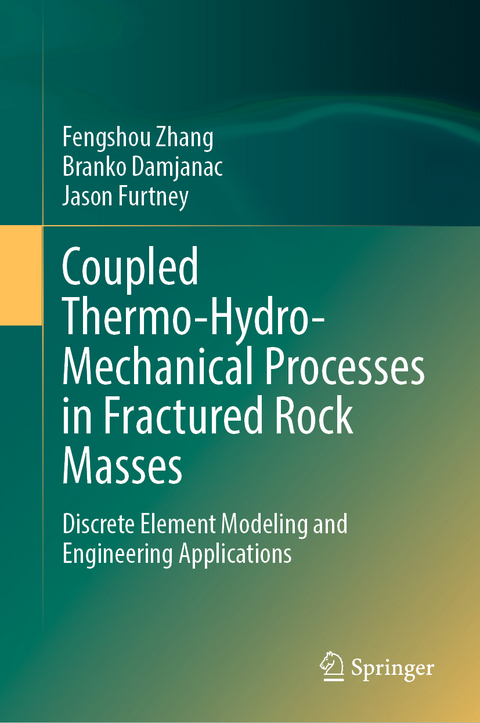
Coupled Thermo-Hydro-Mechanical Processes in Fractured Rock Masses
Springer International Publishing (Verlag)
978-3-031-25786-5 (ISBN)
The subject of thermo-hydro-mechanical coupled processes in fractured rock masses has close relevance to energy-related deep earth engineering activities, such as enhanced geothermal systems, geological disposal of radioactive waste, sequestration of CO2, long-term disposal of waste water and recovery of hydrocarbons from unconventional reservoirs. Despite great efforts by engineers and researchers, comprehensive understanding of the thermo-hydro-mechanical coupled processes in fractured rock mass remains a great challenge. The discrete element method (DEM), originally developed by Dr. Peter Cundall, has become widely used for the modeling of a rock mass, including its deformation, damage, fracturing and stability. DEM modeling of the coupled thermo-hydro-mechanical processes in fractured rock masses can provide some unique insights, to say the least, for better understanding of those complex issues.
The authors of this book have participated in various projects involving DEM modeling of coupled thermo-hydro-mechanical processes during treatment of a rock mass by fluid injection and/or extraction and have provided consulting services to some of the largest oil-and-gas companies in the world. The breadth and depth of our engineering expertise are reflected by its successful applications in the major unconventional plays in the world, including Permian, Marcellus, Bakken, Eagle Ford, Horn River, Chicontepec, Sichuan, Ordos and many more. The unique combination of the state-of-the-art numerical modeling techniques with state-of-the-practice engineering applications makes the presented material relevant and valuable for engineering practice. We believe that it is beneficial to share the advances on this subject and promote some further development.
lt;p>Fengshou Zhang is a distinguished professor in the Department of Geotechnical Engineering at Tongji University, Shanghai, China. He obtained his Ph.D. from the Georgia Institute of Technology in 2012. After that, he worked at Itasca Consulting Group, Inc., for a few years as a geomechanics engineer providing consulting services to the oil and gas industries, before he joined Tongji University in 2016. His research direction is multi-field coupling of rock mechanics and its application in deep earth engineering such as shale gas, dry hot rock and carbon sequestration. He has more than 150 published papers and won the Future Leaders Award (2015) and the Early Career Award (2018) of American Society of Rock Mechanics (ARMA), the first Qian Qihu Award (2020) of Chinese Society of Rock Mechanics and Engineering (CSRME) and the 17th China Youth Science and Technology Award (2022).
Branko Damjanac is a senior principal engineer at Itasca Consulting Group, Inc. He obtained his Ph.D. in rock mechanics from the University of Minnesota in 1996. He has experience in the design and analysis of underground excavations for oil storage and waste isolation. He has been involved in stability analyses of underground and open-pit mines in both hard and soft rocks. He has developed a 3D numerical model to simulate the coupled hydro-mechanical response of a fluid-saturated rock mass. Dr. Damjanac was involved in a number of projects in the petroleum, geothermal and mining industries with the objective of design and operation optimization of rock mass treatment by fluid injection.
Chapter 1: Introduction to the Discrete Element Method (DEM) and Related
Fluid Mechanics Concepts.- Chapter 2: Discrete Element Modeling of Hydraulic Fracturing.- Chapter 3: DEM Coupled with Computational Fluid Dynamics (CFD).- Chapter 4: DEM Coupled with Dynamic Fluid Mesh (DFM).- Chapter 5: DEM Coupled with Lattice-Boltzmann Method (LBM).- Chapter 6: Hydraulic Stimulation of Naturally Fractured Reservoirs.- Chapter 7: Models of Stimulation and Production from Enhanced Geothermal
Systems.- Chapter 8: Hydraulic Fracturing Induced Fault Reactivation.- Chapter 9: 3D Lattice Modeling of Hydraulic Fracturing in Naturally Fractured Reservoirs.- Chapter 10: Heat Advection and Forced Convection in a Lattice Code.- Chapter 11: Near Wellbore HF Propagation for Different Perforation Models.- Chapter 12: Design of Extreme Limited Entry Perforation.
| Erscheinungsdatum | 12.08.2023 |
|---|---|
| Zusatzinfo | XIX, 306 p. 227 illus., 201 illus. in color. |
| Verlagsort | Cham |
| Sprache | englisch |
| Maße | 155 x 235 mm |
| Gewicht | 718 g |
| Themenwelt | Naturwissenschaften ► Geowissenschaften ► Geologie |
| Technik ► Bauwesen | |
| Technik ► Elektrotechnik / Energietechnik | |
| Schlagworte | Discrete fracture network • fracture mechanics • Hydraulic Fracturing • Hydro-mechanical processes • Rock Mechanics • Transport property |
| ISBN-10 | 3-031-25786-3 / 3031257863 |
| ISBN-13 | 978-3-031-25786-5 / 9783031257865 |
| Zustand | Neuware |
| Haben Sie eine Frage zum Produkt? |
aus dem Bereich


